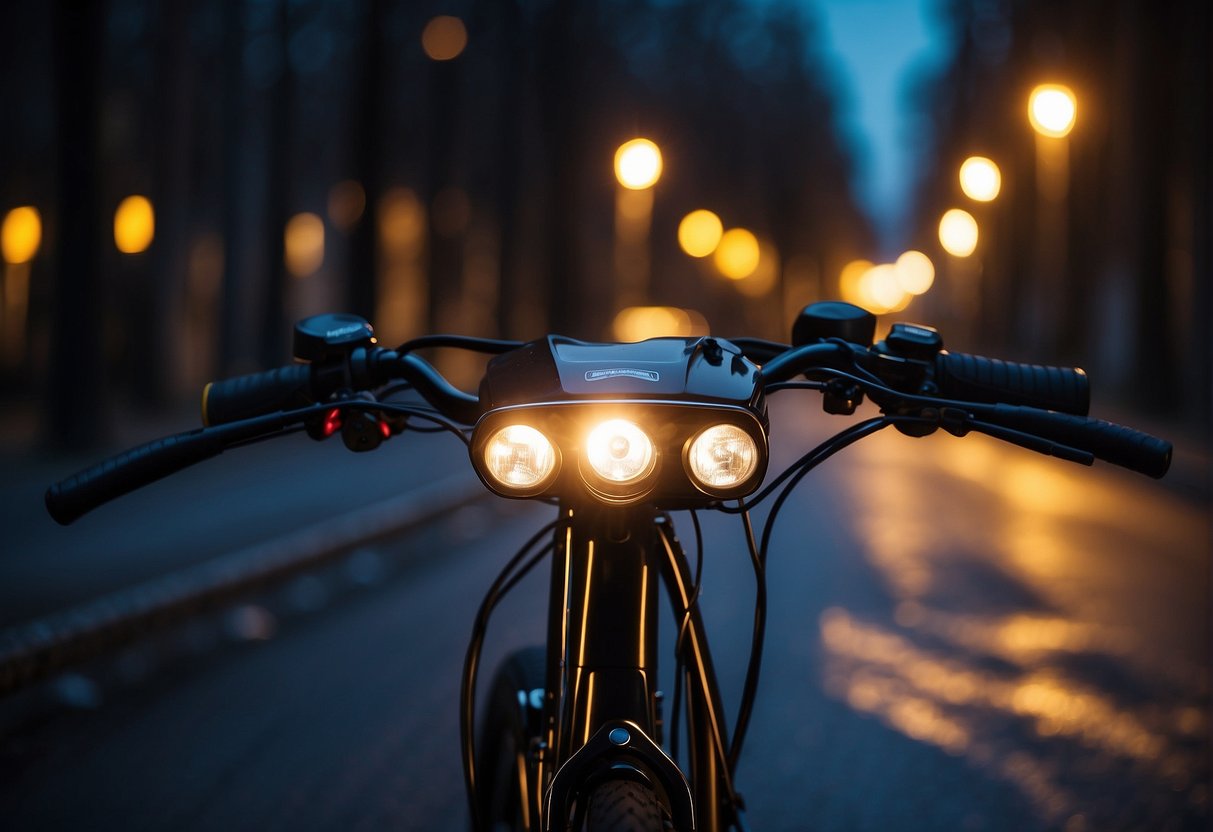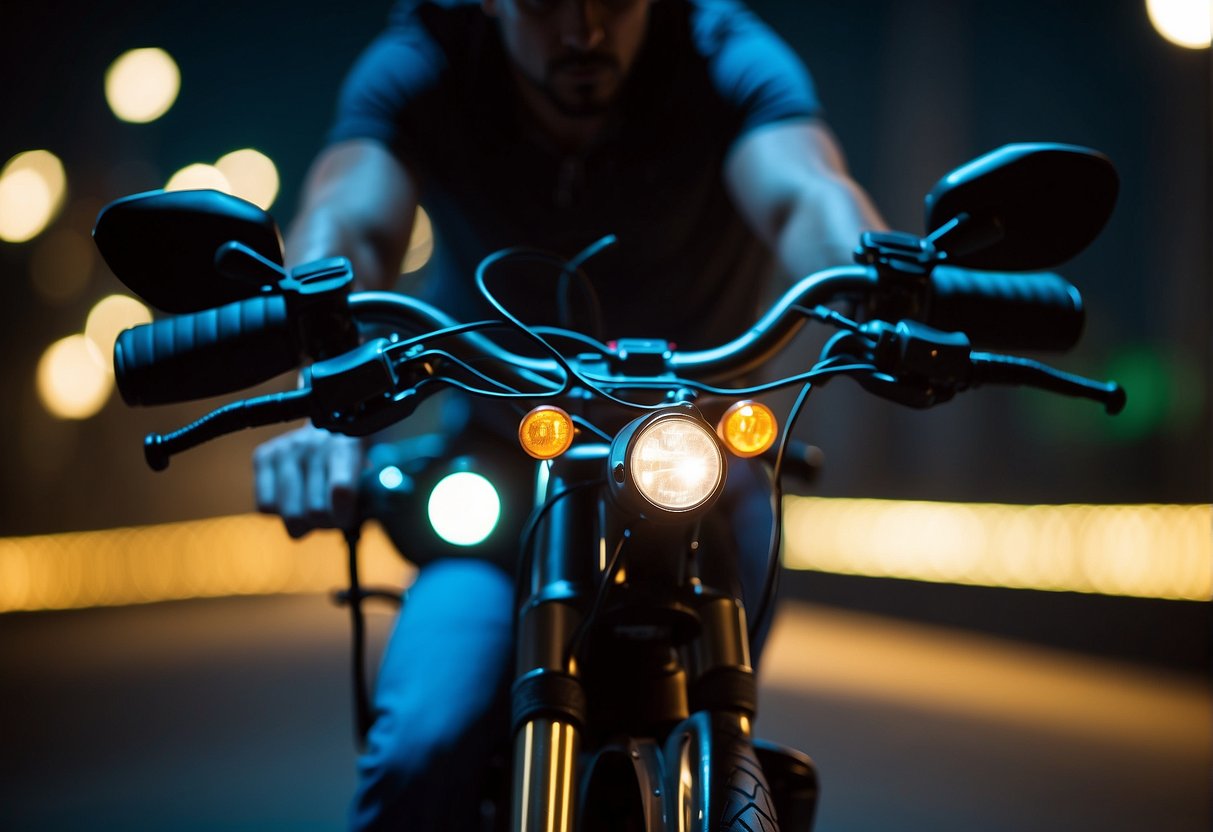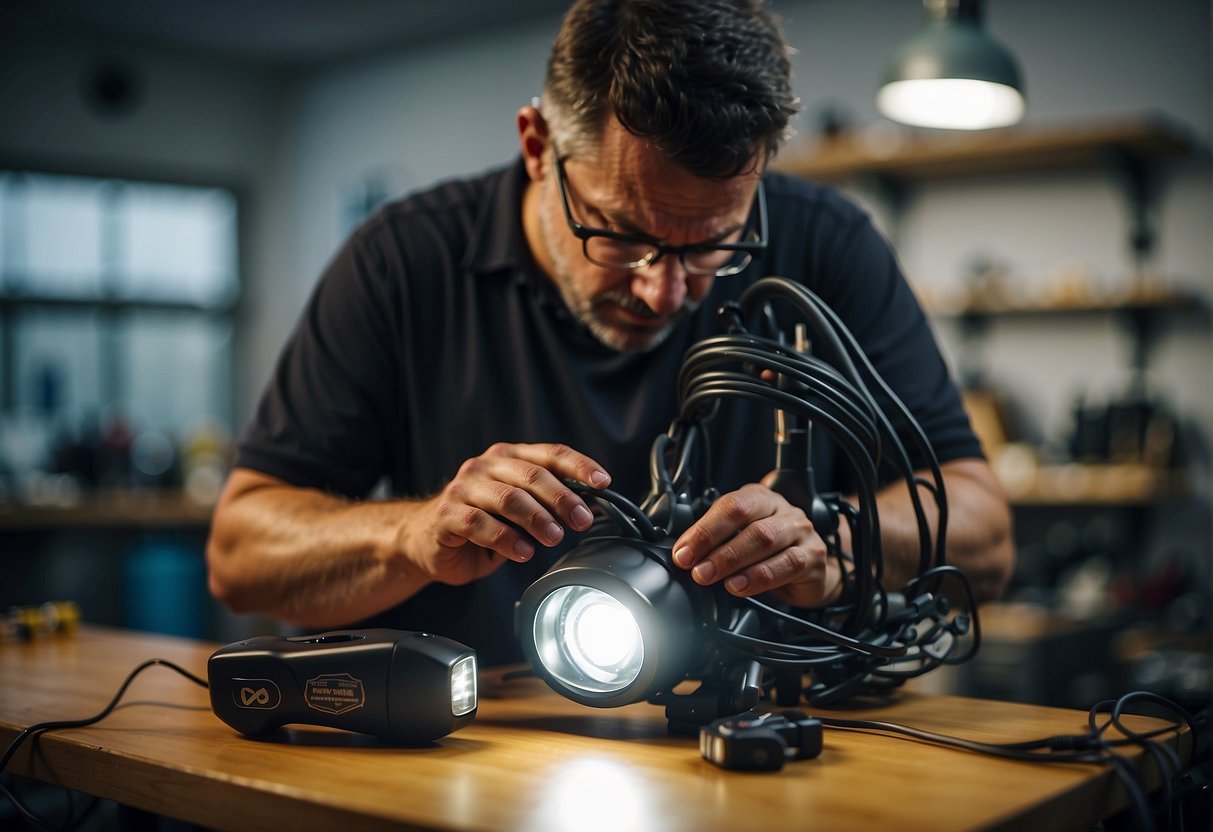Electric Bike Headlight: Illuminating Your Night Rides
*We may earn a commission for purchases made using our links. Please see our disclosure to learn more.
Electric Bike Headlight: Enhancing Nighttime Ride Safety
The electric bike headlight is an essential component for any e-bike rider who values safety and adherence to road regulations. As a frequent cyclist, I understand the crucial role these lights play in ensuring visibility during night rides and in low-light conditions. Not only do they illuminate the path ahead, allowing me to identify obstacles and navigate safely, but they also serve to make me more visible to other road users. Various options are available, ranging from standard LED lights to advanced models with features like integrated horns, adjustable beams, and waterproofing.
The market offers a wide array of electric bike headlights compatible with different voltages and e-bike models. It’s important for me to choose a headlight that meets the specific voltage requirements of my e-bike, as this impacts compatibility and performance. Most e-bike lights operate within a range from 6V to 60V, which suits the majority of electric bikes. Some headlights are specifically designed to be compatible with certain e-bike systems, such as Bosch, and may offer easy installation with clean, integrated connectors.
Selecting the right headlight goes beyond just picking a bright light; it involves considering features like light intensity, measured in lumens, water resistance, and the inclusion of additional safety features, such as built-in horns. My preference is to invest in a quality headlight that provides a bright, adjustable beam, ensuring that I can tailor the light output to the riding conditions. Additionally, a robust construction that withstands the elements is crucial for consistent performance, regardless of weather conditions.
Choosing the Right Electric Bike Headlight

When selecting an electric bike headlight, I consider factors such as brightness measured in lumens, headlight technology, mounting options, and compatibility with different e-bike systems to ensure safety and optimal performance during night rides.
Understanding Headlight Lumen Output
Lumens measure the total amount of visible light emitted by a source, with higher lumens indicating brighter light. For electric bike headlights, a range of 300 to 800 lumens is typically sufficient for urban riding, while trail or rural riding might require upwards of 800 lumens for greater visibility.
LED vs Halogen vs HID Headlights
- LED (Light Emitting Diode): LED headlights are my preferred choice due to their energy efficiency, long life, and high brightness. They offer excellent luminosity with less wattage and generate less heat compared to other types.
- Halogen: Halogen headlights provide warm light and are cost-effective. However, they have a shorter lifespan and lower lumen output per watt than LEDs.
- HID (High-Intensity Discharge): HID lights are brighter than halogens and more efficient but can be more expensive. Their intense brightness is suitable for riders needing maximum visibility.
Headlight Mounting Options for Ebikes
Mounting options include handlebar mounts and helmet mounts, with most electric bikes equipped with mounting brackets suitable for standard fittings. Brands like Planet Bike, Lezyne, and NiteRider offer various mounting systems that can cater to different preferences and requirements.
- Handlebar Mount: Provides a stable, fixed lighting direction that aligns with the bike’s movement.
- Helmet Mount: Offers directional light where I look, ideal for illuminating dark corners or looking at road signs, yet may not be as stable.
Compatibility with Electric Bike Systems
It’s important that the headlight is compatible with the e-bike’s voltage and wattage specifications to ensure proper functioning and avoid electrical issues. Installation procedures can vary, from simple USB-powered setups to integrated systems requiring specific connectors like a Bosch system plug for a streamlined installation. Always check the light’s compatibility with my e-bike model to ensure a smooth installation process.
Headlight Safety and Visibility Features

Ensuring safety while riding an electric bike not only depends on a rider’s vigilance but also on the effectiveness of the bike’s headlight. Enhanced visibility during critical times of day and adaptable brightness levels are essential for a rider’s safety.
Importance of Visibility During Dusk and Dawn
During dusk and dawn, visibility on the road is compromised due to the low light conditions. This is why it’s imperative for electric bike headlights to be brighter and have a wide angle of illumination. Greater visibility during these times assures that I am seen by other road users and can also clearly see the path ahead.
Added Safety with LED Halos and Rock Guards
An LED halo around the main headlight significantly increases added visibility, serving as a daytime running light. This feature can make me more noticeable to oncoming traffic, regardless of the time of day. Furthermore, a removable rock guard can protect the headlight from debris and ensure that it remains functional for added safety.
Adjusting Headlight Brightness for Road Conditions
Adapting the headlight brightness to current road conditions is crucial. For instance, brighter lights are ideal for dark rural roads, while a dimmer setting might be more appropriate for well-lit urban areas to prevent blinding other riders or drivers. Some electric bike headlights offer settings that I can adjust manually, while others automatically adapt to ambient light conditions.
Powering Your Headlight

In managing and maintaining the headlight of an electric bike, understanding the integration with the bike’s battery and effective battery life management are pivotal to ensure continuous and optimal illumination.
Ebike Battery Integration
My electric bike’s headlight draws power directly from my ebike’s main battery. This integrated system provides a seamless and efficient power source, eliminating the need for separate batteries for the headlight. For example, when I use a Bosch-powered ebike, I often utilize a Bosch system plug for neat and straightforward installation. Shimano and Stromer systems offer similar integration options, with specific connectors and current power cables that match their respective batteries. To power the headlight, it’s as simple as flipping the switch that’s typically located on the handlebar or control unit to the “on” position.
Ebike Battery Connections:
- Bosch System: Utilizes Bosch system plug
- Shimano: Proprietary Shimano connector
- Stromer: Stromer interface
- Toshiba: Adjustable to Toshiba connections
Integrating the headlight with the ebike battery ensures that I don’t have to worry about the headlight’s power source getting depleted separately from the ebike, as they share a single charge.
Headlight Battery Life and Management
To optimize my headlight’s battery life, I keep an eye on my ebike battery’s overall charge levels, since the same battery powers both the drivetrain and the headlight. Consistent management involves charging the battery fully before rides, especially if I anticipate using the headlight for extended periods at night or during low-light conditions.
The battery life varies based on the ebike model and usage, but I take care to not let my battery drain completely, as this can affect its longevity. Periodically checking the battery health and the connections ensures that I am not caught off guard with a dimming or non-functional headlight. Also, it’s good practice to switch off the headlight when it’s not in use to conserve power.
By managing the headlight’s power usage diligently, I ensure it provides a bright, consistent beam that enhances visibility and safety during my rides.
Installation and Upgrades

When installing or upgrading an electric bike headlight, I focus on ensuring adequate brightness and ease of installation. Upgrades often provide a seamless enhancement in both light output and visibility.
Installing Your Headlight on an Electric Bike
My first step is always to turn off the bike and remove the battery. I ensure to discharge any remaining power by pressing and holding the MODE or power button. I then locate the headlight’s connector and carefully unplug it by pulling each side directly apart without twisting. The original headlight and mounting hardware need to be removed carefully.
For the installation itself, I:
- Identify the correct position for the new headlight on the front fork.
- Use appropriate tools (usually a 5 mm Allen wrench and a 10 mm wrench) to secure the headlight.
- Connect the new headlight to the bike’s electrical system.
- Test the headlight to make sure it’s functioning correctly.
Upgrading to a Premium Electric Bike Headlight
When I decide to upgrade to a premium headlight, my main considerations are higher brightness and a more focused beam for better visibility. A premium headlight typically offers a more robust output, measured in lumens, and ensures I am visible at greater distances.
My upgrade process:
- Remove the stock headlight using the tools mentioned above.
- Choose a premium headlight compatible with my Lectric eBike for full wattage utilization.
- Attach the headlight, reusing the existing mounting hardware for a seamless upgrade.
- Connect the headlight to the eBike’s battery to ensure it draws power correctly.
By following these steps, I can enhance my nighttime riding experience significantly with a premium headlight that’s both bright and efficient.
Electric Bike Headlight Specifications and Regulations

When selecting an electric bike headlight, it’s essential to understand the technical specifications and legal obligations. The right headlight not only ensures visibility but also complies with safety regulations.
Evaluating Product Specifications
When selecting a headlight, I consider luminosity, measured in lumens, to determine brightness. A higher lumen count typically indicates a brighter light. For wiring, many eBike headlights are hardwired to the bike’s battery system, ensuring efficient power usage and seamless integration. Some lights are designed for specific eBike systems like Bosch, and may include system plugs for clean installation.
- Brightness: Ideally, a headlight should have at least 500 lumens for adequate road illumination.
- Wiring: Look for compatibility with your eBike’s electrical system.
- Mounting: The headlight should securely attach to the bike’s frame or handlebar.
- Durability: A quality headlight should be weatherproof to resist rain and fog.
Understanding California Proposition 65 Warning
California’s Proposition 65, also known as the Safe Drinking Water and Toxic Enforcement Act of 1986, necessitates businesses to provide warnings about significant exposures to chemicals that cause cancer, birth defects, or other reproductive harm. As an informed consumer, I look for Proposition 65 warnings on product packaging to identify if the product exposes me to such chemicals.
- The State of California maintains a list of these chemicals.
- Products containing such chemicals must include a Proposition 65 warning label.
- Exposure risks may stem from use or handling of the product.
FAQs About Your Electric Bike Headlight
In this section, I’ll address some of the common inquiries concerning electric bike headlights, focusing on aspects such as upgrading, purchasing, installation, and maintenance to ensure your night rides are safe and well-lit.
1. How can I upgrade the headlight on my electric bike?
To upgrade my electric bike headlight, I prioritize compatibility with my bike’s voltage and check the lumen rating for improved brightness. I ensure the new light fits my mount and consider models with integrated features like hi/lo beam or weatherproofing.
2. What should I consider when looking for an electric bike headlight kit?
When selecting an electric bike headlight kit, I consider the light’s brightness, measured in lumens, its power source compatibility, and the ease of installation. I also look for durability, especially weatherproofing, to ensure it stands up to various riding conditions.
3. Which headlight is considered the best for visibility on electric bikes?
The best headlight for visibility on electric bikes usually has a high lumen output, offering a balance between a focused beam and a wide-angle spread. Features such as LED technology and the capability to adjust the angle help enhance visibility during night riding.
4. How do I turn on the headlight of my electric bike?
I turn on the headlight of my electric bike by locating the designated switch on the bike’s interface or handlebar. I press the switch until it clicks, indicating that the headlight is active. It’s important to check the light’s functionality every time before I set out.
5. How do I install a DIY headlight on my electric bike?
To install a DIY headlight on my electric bike, I choose the appropriate mounting spot, secure the headlight with brackets or straps, and connect it to the bike’s power source. I follow the manufacturer’s instructions closely to ensure proper installation and function.




